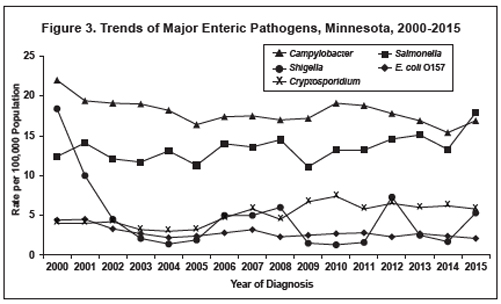Annual Summary of Disease Activity:
Disease Control Newsletter (DCN)
Related Topics
Contact Info
Escherichia coli O157 Infection and Hemolytic Uremic Syndrome (HUS), 2015
During 2015, 115 culture-confirmed cases of Escherichia coli O157:H7 infection (2.09 per 100,000 population) were reported (Figure 3). The number of reported cases represents a 15% decrease from the median number of cases reported annually from 2005 to 2014 (median, 136 cases; range, 120 to 163). Forty-nine (43%) cases occurred in the metropolitan area. Ninety-three (81%) cases occurred during May through October. The median age of the cases was 21 years (range, 4 months to 101 years). Twenty percent of the cases were 4 years of age or younger. Thirtyseven (32%) cases were hospitalized; the median hospital stay was 3 days (range, 1 to 33 days). No cases died.
In addition to the 115 culture-confirmed E. coli O157 cases, 125 cases of Shiga toxin-producing E. coli (STEC) infection were identified in 2015. Of those, culture-confirmation was not possible in 17, and therefore it is unknown if those were O157 or another serogroup. Among the remaining 108 cases with STEC other than O157, E. coli O103 accounted for 38 (35%) cases, E. coli O26 for 33 (31%), and E. coli O111 for 22 (20%). The median age of the non-O157 STEC cases was 23 years (range, 2 months to 88 years). Twentyeight (26%) cases were hospitalized; the median hospital stay was 3 days (range, 1 to 22 days). No cases died.
Nine E. coli O157 outbreaks were identified during 2015. Five outbreaks involved foodborne transmission, two outbreaks were due to person-to-person transmission in daycares, and two outbreaks were due to animal contact. The nine outbreaks resulted in 43 illnesses (34 laboratory-confirmed) with a median of 3 cases per outbreak (range, 2 to 15 cases).
In June, an outbreak of E. coli O157 infections was associated with a restaurant. Two cases, both laboratoryconfirmed, were identified. A vehicle was not identified. Also, an outbreak of E. coli O157 infections associated with person-to-person transmission occurred at a daycare in Murray County. Fifteen cases, 9 laboratory-confirmed, were identified.
In July, an outbreak of E. coli O157 infections associated with person-to-person transmission occurred at another daycare in Murray County. Five cases, all laboratory-confirmed, were identified. Also, an outbreak of E. coli O157 infections was associated with animal contact at a county fair. Four cases, all laboratory-confirmed, were identified, and 1 case developed HUS. The source of this outbreak was likely calves or goats but animal testing to determine a specific source could not be conducted.
In August, an outbreak of E. coli O157 infections was associated with animal contact at a county fair. Two cases, both laboratory-confirmed, were identified.
In September, an outbreak of E. coli O157 infections was associated with a restaurant. Seven cases, 5 laboratoryconfirmed, were identified. A vehicle was not identified.
In October, an outbreak of E. coli O157 infections was associated with consumption of unpasteurized apple cider purchased at an orchard. Two cases, both laboratory-confirmed, were identified. Also, an outbreak of E. coli O157 infections was associated with beef and goat meat purchased from a live animal market. Three cases, two laboratory-confirmed, were identified.
In December, a multistate outbreak of E. coli O157 infections associated with consumption of dessert pizza at a restaurant chain was identified. Five cases, all laboratory-confirmed, were identified in Minnesota. Two cases had illness onsets in December and 3 had illness onsets in January 2016.
One non-O157 STEC outbreak was identified during 2015. In October, a multistate outbreak of E. coli O26 infections was associated with eating at a restaurant chain. Two cases, both laboratory-confirmed, were identified in Minnesota. A vehicle was not identified.
Hemolytic Uremic Syndrome (HUS)
In 2015, 11 HUS cases were reported. The number of reported cases represents a 33% decrease from the median number of cases reported annually from 2005 to 2014 (median, 16.5 cases; range, 10 to 22). In 2015, the median age of HUS cases was 3.6 years (range, 1 to 87 years); 6 of the 11 cases occurred in children less than 7 years of age. All 11 cases were hospitalized, with a median hospital stay of 14 days (range, 6 to 34 days). No cases died. From 1997 through 2015, the overall case fatality rate among HUS cases was 5.1%. All 11 HUS cases reported in 2014 were post-diarrheal. E. coli O157:H7 was cultured from the stool of 9 (82%) cases. In 2015, there was 1 outbreak-associated HUS case.

- For up to date information see:E. coli O157:H7 and HUS
- Full issue>> Annual Summary of Communicable Diseases Reported to the Minnesota Department of Health, 2015